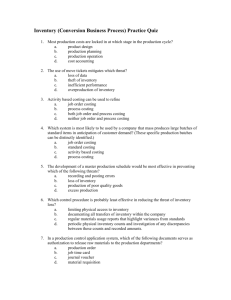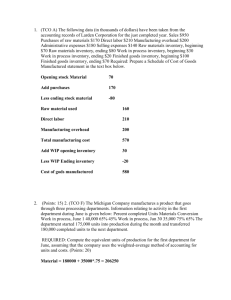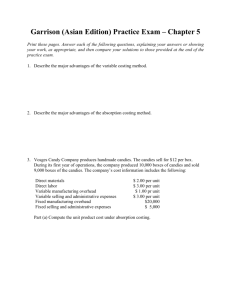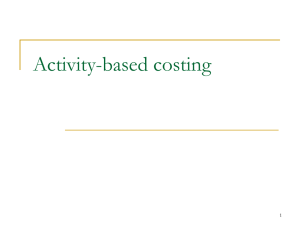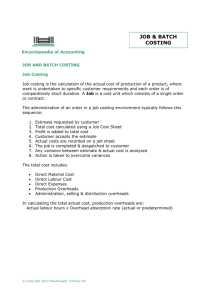Absorption and marginal costing - Hong Kong Institute of Accredited
advertisement
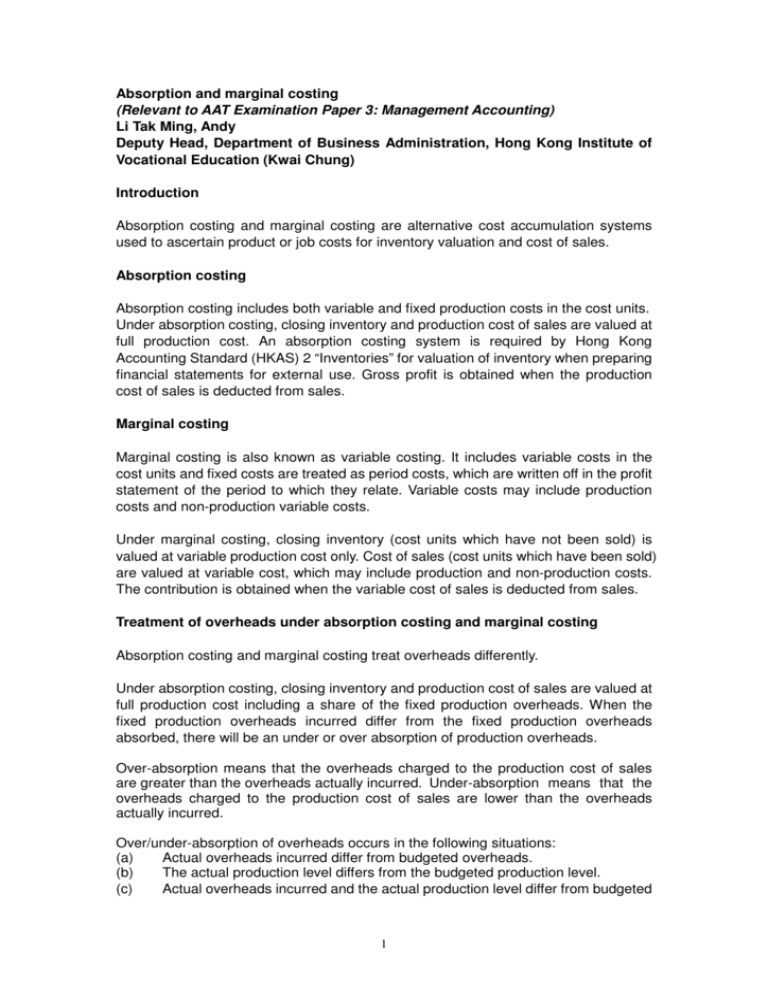
Absorption and marginal costing (Relevant to AAT Examination Paper 3: Management Accounting) Li Tak Ming, Andy Deputy Head, Department of Business Administration, Hong Kong Institute of Vocational Education (Kwai Chung) Introduction Absorption costing and marginal costing are alternative cost accumulation systems used to ascertain product or job costs for inventory valuation and cost of sales. Absorption costing Absorption costing includes both variable and fixed production costs in the cost units. Under absorption costing, closing inventory and production cost of sales are valued at full production cost. An absorption costing system is required by Hong Kong Accounting Standard (HKAS) 2 “Inventories” for valuation of inventory when preparing financial statements for external use. Gross profit is obtained when the production cost of sales is deducted from sales. Marginal costing Marginal costing is also known as variable costing. It includes variable costs in the cost units and fixed costs are treated as period costs, which are written off in the profit statement of the period to which they relate. Variable costs may include production costs and non-production variable costs. Under marginal costing, closing inventory (cost units which have not been sold) is valued at variable production cost only. Cost of sales (cost units which have been sold) are valued at variable cost, which may include production and non-production costs. The contribution is obtained when the variable cost of sales is deducted from sales. Treatment of overheads under absorption costing and marginal costing Absorption costing and marginal costing treat overheads differently. Under absorption costing, closing inventory and production cost of sales are valued at full production cost including a share of the fixed production overheads. When the fixed production overheads incurred differ from the fixed production overheads absorbed, there will be an under or over absorption of production overheads. Over-absorption means that the overheads charged to the production cost of sales are greater than the overheads actually incurred. Under-absorption means that the overheads charged to the production cost of sales are lower than the overheads actually incurred. Over/under-absorption of overheads occurs in the following situations: (a) Actual overheads incurred differ from budgeted overheads. (b) The actual production level differs from the budgeted production level. (c) Actual overheads incurred and the actual production level differ from budgeted 1 overheads and the budgeted production level. Under marginal costing, closing inventory and production cost of sales are valued at variable production cost only. Fixed production overheads are written off as they are incurred in the period as a period cost in the profit statement. Since there is no absorption of fixed production overheads, there is no under- or over-absorption of production overheads. Example 1 (AAT Paper 3: Management Accounting, December 2009, Modified) Jaguar Industrial Limited makes and sells one product, which has the following standard variable production costs per unit. $ Direct materials cost (2 kg at $25 per kg) 50 Direct labour cost (3 hours at $40 per hour) 120 Variable production overhead costs ($10 per labour hour) 30 The budgeted selling price per unit is $400 for the coming two years. The production and sales budgets for the next two years are as follows: 2011 2010 Production in units 50,000 60,000 Sales in units 40,000 70,000 There is no opening inventory at the beginning of 2010. Budgeted fixed production overhead costs are $20 per unit, and they are absorbed based on a normal production level of 54,000 units per annum. The budgeted non-production costs for the next two years are as follows: Variable non-production overhead costs Fixed non-production overhead costs per annum $10 per unit sold $2,000,000 Required: Prepare the budgeted operating statements for each of the coming two years, in a columnar format using absorption and marginal costing systems separately. Budgeted operating statement for the year ended 31 December (absorption costing system) 2010 2011 $’000 $’000 Sales 16,000 28,000 Less: Production costs of sales Opening inventory 2,200 Add: Variable production overhead costs (W1) 10,000 12,000 Fixed production overhead costs 1,000 1,200 11,000 15,400 Less: Closing inventory 2,200 8,800 15,400 Under/(Over) absorbed fixed production costs (W2) 80 (120) 8,880 15,280 Gross profit 7,120 2 12,720 Less: Variable non-production overhead costs (W3) Fixed non-production overhead costs 400 2,000 2,400 700 2,000 2,700 Net profit 4,720 10,020 Budgeted operating statement for the year ended 31 December (marginal costing system) 2010 2011 $’000 $’000 Sales 16,000 28,000 Less: Variable production costs of sales Opening inventory 2,000 Add: Variable production overhead costs (W1) 10,000 12,000 10,000 14,000 Less: Closing inventory 2,000 8,000 14,000 Variable non-production overhead costs (W3) 400 700 8,400 14,700 Contribution 7,600 13,300 Less: Fixed production overhead costs Fixed non-production overhead costs 1,080 2,000 3,080 1,080 2,000 3,080 Net profit 4,520 10,220 Workings: (W1) 2010: $(50 + 120 + 30) × 50,000 = $10,000,000 2011: $(50 + 120 + 30) × 60,000 = $12,000,000 (W2) 2010: (54,000 – 50,000) x $20 = $80,000 2011: (54,000 – 60,000) x $20 = ($120,000) (W3) 2010: $10 × 40,000 = $400,000 2011: $10 × 70,000 = $700,000 Reconciliation of profits under absorption and marginal costing systems When there is no inventory at the beginning and the end of a period, or no changes in the levels of inventory in a period (i.e. the production quantity is equal to the sales quantity in the period), absorption costing and marginal costing provide the same profit figures for the period. When there are changes in the inventory levels, the two systems will result in different profits. The differences are attributed to the timing of when fixed production overheads are expensed. If the inventory level is rising (i.e. the production quantity exceeds the sales quantity in the period), then the profit under absorption costing will be higher than that under 3 marginal costing because a greater amount of fixed production overheads in the closing inventory is being deducted from the expenses of the period than is being brought forward in the opening inventory for the period. If inventory level is falling (i.e. the sales quantity exceeds the production quantity in the period), then the profit under marginal costing will be higher than that under absorption costing because a larger amount of fixed production overheads are brought forward as an expense in the opening inventory than is being deducted in the closing inventory adjustment. Example 2 (AAT Paper 3: Management Accounting, December 2009, Modified) Based on the information given in Example 1 above. Required: Reconcile the profits reported in the answer to (a) of Example 1 above for each of the coming two years. Reconciliation of the budgeted profits for 2010 and 2011: Absorption costing profit 2010 – Adjust for fixed overheads in inventory (10,000 units × $20) 2011 – Adjust for fixed overheads in inventory (10,000 units × $20) Marginal costing profit 2010 $’000 4,720 (200) 4,520 2011 $’000 10,020 200 10,220 Increase the profit by undesirable building up of inventory Under the absorption costing system, the operating profit of a period could be boosted by building up inventories, i.e. increasing the production even if there is no increase in demand for the product. The increase in reported operating profit is due solely to the fixed production costs carried forward in closing inventory values as inventories increase. However, when the inventory level drops in a later period, the fixed production costs will be released out of inventory and the operating profit will decrease. This type of profit manipulation is undesirable as there is no genuine increase in profit as a whole. There are various ways that senior management can take to reduce the undesirable effects of building up inventory under absorption costing. One possible way is to exercise careful inventory planning and control to reduce the freedom to build up unnecessary inventory. References: Colin Drury, Management and Cost Accounting, 7th Edition 2008, South-Western Andy Tak-ming Li & Patrick Kin-wai Ho, BAFS in the New World, Accounting – Elective Part 2 Cost Accounting, First Edition 2010, Pilot Publishing Company Ltd. 4


